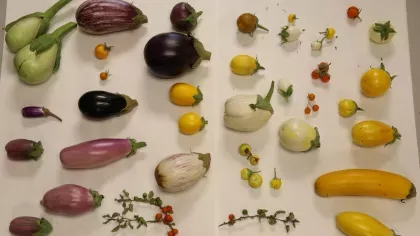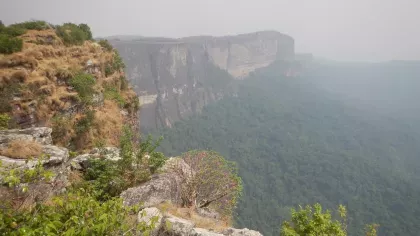17 December 2019
Top 10 species discovered in 2019
Our scientists have once again been busy identifying and describing new plant and fungal species.

This year our researchers, working with partners, published the discoveries of 102 vascular plants and eight species of fungi from across the world.
Nearly half of these were from Africa, with most published by Iain Darbyshire, who leads the Tropical Important Plant Areas (TIPAs) programme.
Most of these new species are threatened with extinction and naming them is vital for their survival.
Here we showcase our top 10 species of 2019, some of which may help to provide us with new foods, materials or medicines.
-

Candy-striped violet
A spectacular new species from the African violet family, Cyrtandra vittata, was discovered in northern New Guinea.
The striking, bright pink candy-striped flower grows on a shrub in the rainforest. Flowers of this rainforest shub are followed by white berries which are thought to be dispersed by doves and pigeons.
Collected from the wild under permit by intrepid scientists at the Royal Botanic Garden, Edinburgh, once propagated from cuttings, it was discovered to be a new species when it flowered in cultivation.
Cyrtandra vittata is one of about 800 species which range from herbs to small trees and occur from Thailand to the Hawaiian Archipelago. Most species occur in the Philippines, Borneo or New Guinea.
-

Sour to sweet: the 'miracle-berry'
Synsepalum chimanimani, a new species of ‘miracle-berry’, was discovered in the lowland rainforests of the Chimanimani Mountains on the Mozambique - Zimbabwe border in Africa.
The fruits of Synsepalum are slightly sweet to taste, but contain a compound called miraculin that blocks taste buds, so that when sour foods are eaten, such as limes, they taste sweet.
It's a small tree, just four metres in height, with glossy evergreen leaves produced in small bunches. The twigs produce a white rubbery latex when cut. Fewer than 40 species are known, all from tropical African forests.
The new species has been assessed as ‘endangered’ as it’s only known to exist in three locations, all of which are under threat from deforestation for agriculture.
-

Medicinal fungus
A medicinal fungus, known in China for over 400 years, ‘Zhuhongjun’ (now formally named Rubroshiraia bambusae), was discovered to be a genus, as well as a species previously unknown to science.
Native to Yunnan in South West China, it grows on a species of bamboo forming pink, ball-like fruiting bodies.
The fungus is used as traditional medicine to treat arthritis and infantile convulsion.
Scientific interest has increased due to the discovery of compounds in the fungus known as ‘hypocrellins’.
Hypocrellins have gained much attention owing to their light-induced anti-tumour, anti-fungal, anti-viral and anti-microbial activities. Further research into the medicinal properties of this fungus are ongoing.
-

A snowdrop in a holiday photo
A new snowdrop, Galanthus bursanus, from North West Turkey was discovered on Facebook when Turkish paediatrician, Dr Y Konca, uploaded her holiday photos.
Ukrainian researcher, Dr Dimitri Zubov, spotted that the snowdrops were something special.
They both went back to find the location in the photo, collected a sample of the plant and contacted our snowdrop specialist Aaron Davis.
Unfortunately, the snowdrop, has already been assessed as ‘critically endangered’ due to threats from illegal collecting, marble quarrying, climate change and expansion of agricultural land.
-

Waterfall seaweed 'orchid'
Inversodicraea koukoutamba was discovered on a waterfall on the Bafing River in Guinea, West Africa. It hasn't been found anywhere else.
The new species, identified to be in the family known as the ‘orchids of the falls’ is a rubbery, seaweed shrub which grows to 20cm tall.
It's expected to become globally extinct when construction on a planned hydro-electric project in the area begins next year.
Hydropower projects usually target waterfalls and have caused several species of this family to go extinct already in other parts of Africa.
With other species of this same plant family known to hold medicinal properties and are edible, their conservation is important.
-

Bears’ breeches
Ten new bears’ breeches were found this year in tropical Africa, including two ‘showy’ blue-flowered flower species of Baleria, found in Angola: Barleria deserticola and Barleria namba.
B. deserticola, from the Namib coastal desert, was first collected 160 years ago by the explorer Friedrich Welwitsch. It was re-found in 2017 by US botanist Erin Tripp, finally allowing this species to be named this year by Kew.
B. namba only came to light very recently, having been discovered by David Goyder on the previously unexplored Mount Namba.
-

Volcano herb
Costularia cadetii, a perennial herb, grows on the rims of the volcanoes on Réunion Island in the Indian Ocean.
The first record of this species was collected in 1965 but further material was needed, and it was only officially named this year.
Isabel Larridon named the herb after its collector Thérésian Cadet, a former teacher and climbing enthusiast of the island.
The species is already classified as 'endangered' as it is restricted to this high elevation habitat which puts it at risk from volcanic activity, fire and climate change.
-

From Guinea with love
Found growing on a table-stone mountain in Kounounkan, in Guinea, is the Gladiolus mariae.
Kew scientist Xander van der Burgt found the vivid orange flower to be restricted to two mountains in the area – the mountains are among the last to remain unimpacted by humans.
It likes to grow in fire-free habitats and occurs in open vegetation with little grass.
Xander decided to name the beautiful and unique flower after his wife Maria.
-

A rare discovery
With just seven trees known on Earth, Zonozono (Mischogyne iddii), a 20m tall tree in the ylang-ylang family, is perhaps the rarest species described this year.
It was named by its discoverers, George Gosline and Andy Marshall, in honour of the Tanzanian botanist Iddi Rajabu and has been identified in a genus previously only known from Central Africa.
It is assessed as 'endangered' due to the low number of individuals, and threats from pole-cutting and an invasive tree species.
-

Andean forest finds
11 new species of trees and shrubs have been discovered in the Andean forests in South America this year.
These new trees could have many uses. Some species of the genus are known to produce compounds which could be of medicinal or biochemical value.
Other species have also been proposed as conservatory plants because of their attractive glossy, variously sculptured leaves.
The new species are restricted to relatively small areas of montane and cloud forest in South America in Bolivia, Ecuador, and Peru.
Sadly, all 11 have been assessed as ‘threatened with extinction’, mainly due to their small distributions, rarity and increasing habitat destruction in the area.
Species publications
Galanthus bursanus
Zubov, D.A., Konca, Y. & Davis, A.P. (2019) Galanthus bursanus (Amaryllidaceae): a new species of snowdrop from the Marmara Sea region, NW Turkey. Kew Bulletin 74: 18.
Synsepalum chimanimani
Rokni, S., Wursten, B. & Darbyshire, I. (2019). Synsepalum chimanimani (Sapotaceae), a new species endemic to the southern foothills of the Chimanimani Mountains of Mozambique and Zimbabwe, with notes on the botanical importance of this area. PhytoKeys 133: 115-132.
Inversodicraea koukoutamba
Cheek, M., Denise, M., Jennings, L., Magassouba, S. & van der Burgt, X. (2019). Inversodicraea koukoutamba and I. tassing (Podostemaceae), new waterfall species from Guinea, West Africa. Blumea 64:216-224.
Rubroshiraia bambusae
Dai, Dong-Qin et al. (2019). Rubroshiraia gen. nov., a second hypocrellin-producing genus in Shiraiaceae (Pleosporales). MycoKeys 58: 1-26.
Barleria deserticola and Baleria namba
Darbyshire, I., Tripp, E.A. & Chase, F.M. (2019) A taxonomic revision of Acanthaceae tribe Barlerieae in Angola and Namibia. Part 1. Kew Bulletin 74: 5.
Cyrtandra vittata
Atkins, H.J., Heatubun, C.D., Galloway, L. & Bramley, G.C. (2019). Two new species, Cyrtandra bungahijau and C. vittata, and notes on Cyrtandra (Gesneriaceae) from Yapen Island, Indonesia. Kew Bulletin 74: 29.
Eleven new species from Andean Forests
Santamaría-Aguilar, D. & Monro, A.K. (2019) Compendium of Freziera (Pentaphylacaceae) of South America including eleven new species and the typification of 22 names. Kew Bulletin 74: 14.
Costularia cadetii
Larridon, I., Rabarivola, L., Xanthos, M. & Muasya, A.M. (2019). Revision of the Afro-Madagascan genus Costularia (Schoeneae, Cyperaceae): infrageneric relationships and species delimitation. PeerJ 7:e6528
Gladiolus mariae
Burgt X. M. van der, Konomou G., Haba P. M. & Magassouba S. (2019). Gladiolus mariae (Iridaceae), a new species from fire-free shrubland in the Kounounkan Massif, Guinea. Willdenowia 49: 117–126.
Mischogyne iddii
Gosline, G., Marshall, A.R. & Larridon, I. (2019). Revision and new species of the African genus Mischogyne (Annonaceae). Kew Bulletin 74: 28.




